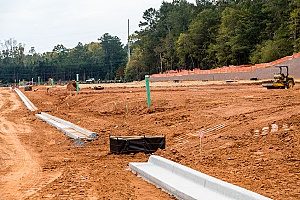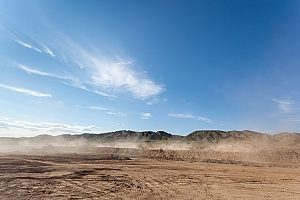Site Preparation
 Site preparation involves all of the necessary steps you have to take before construction actually begins. This includes figuring out and fixing as many problems as possible before construction starts. One of the essential parts of site preparation is taking into consideration the topography of the land and determining if any land grading is required. To figure this out, it is a good idea to have the house rough-staked on the property. This means placing stakes to determine the approximate location of the house. From there, you can see how the land will work with the placement of your home. These stakes can help you determine if trees need to be removed, if drains need to be installed, or if the land needs to be altered to prevent flooding or to make it more suitable to build on top of. As your lot is located in Maryland, it is very likely that the land is not completely flat and that some alterations are going to have to be made. To make these changes, you are going to want to use Maryland fill dirt for your land grading. Reach out to a Maryland fill dirt contractor for more information and to schedule your residential dirt grading site work.
Site preparation involves all of the necessary steps you have to take before construction actually begins. This includes figuring out and fixing as many problems as possible before construction starts. One of the essential parts of site preparation is taking into consideration the topography of the land and determining if any land grading is required. To figure this out, it is a good idea to have the house rough-staked on the property. This means placing stakes to determine the approximate location of the house. From there, you can see how the land will work with the placement of your home. These stakes can help you determine if trees need to be removed, if drains need to be installed, or if the land needs to be altered to prevent flooding or to make it more suitable to build on top of. As your lot is located in Maryland, it is very likely that the land is not completely flat and that some alterations are going to have to be made. To make these changes, you are going to want to use Maryland fill dirt for your land grading. Reach out to a Maryland fill dirt contractor for more information and to schedule your residential dirt grading site work.
Maryland Land Grading
In terms of construction, land grading is the process of making a level or slope base. In this case, you will create a flat surface for the foundation of your home and use fill dirt to ensure proper rainwater drainage. This is a step that absolutely cannot be skipped because Maryland sees its fair share of rainstorms and snowstorms and if the water is not properly draining, over time the excess water could begin to compromise the structure of your home. One of the most useful materials to use for land grading is Maryland fill dirt because its composition doesn’t contain any organic matter which would decompose over time and cause the dirt to shift. Maryland fill dirt is used to fill in any low points in the land to ensure that the land is level. It’s important to make sure that the land is level where you’re going to be building the foundation of your new home. Just like filling in low points, you can also use Maryland fill dirt to build up certain areas of the land to create a more hilly terrain.
Maryland Fill Dirt
 Maryland fill dirt is taken from the ground below the top nutrient-rich topsoil layer. This is important because it does not contain organic matter, which means that over time the dirt won’t shift due to the breakdown of this organic matter. Fill dirt is easy to get in Maryland and there’s an abundance of it, which is great news for you because it means that it is cheap. If you are purchasing fill dirt in a large quantity you may even be able to qualify for getting free Maryland fill dirt.
Maryland fill dirt is taken from the ground below the top nutrient-rich topsoil layer. This is important because it does not contain organic matter, which means that over time the dirt won’t shift due to the breakdown of this organic matter. Fill dirt is easy to get in Maryland and there’s an abundance of it, which is great news for you because it means that it is cheap. If you are purchasing fill dirt in a large quantity you may even be able to qualify for getting free Maryland fill dirt.
For land grading, Maryland fill dirt is used to change the appearance of terrain by creating hills or filling dips and holes to create your desired foundation. Land grading is an extremely important step in the site preparation of your residential construction project.
Rough Grading
Rough grading can be considered “shaping” your home site. The purpose is to level the ground or create a specific slope that a solid base can be built upon. Rough grading is done to meet city guidelines, direct surface water away from the home, and prevent any foundation damage that could occur in the future. This is also the step when concrete will be poured into holes that will become the connection between your house’s foundation walls and the ground. The rough grading must be inspected before construction can continue.
Rough grading is what follows the rough-staking of your property. This is when the land is actually changed to make the accommodations you need. It’s best to get as much of the grading done as possible in this stage because it will help prevent any bad surprises that could occur during the actual construction of the home. This stage of the process is going to be dealing with most of the large grading issues, like any uneven land that could compromise the foundation of the home. Rough grading is when you are going to require the most Maryland fill dirt during your residential construction project.
 Unfortunately, this step in your home’s construction relies heavily on the weather. The land must be completely dry and solid for proper grading, which means that generally, at least three days must pass without rain. In Maryland, the ideal time for land grading is going to occur in the summer months once the heavy rainfall of spring has passed. Because the land grading has to be done while the ground isn’t frozen, there is only a small window of months where it can be completed before temperatures begin to drop in the fall.
Unfortunately, this step in your home’s construction relies heavily on the weather. The land must be completely dry and solid for proper grading, which means that generally, at least three days must pass without rain. In Maryland, the ideal time for land grading is going to occur in the summer months once the heavy rainfall of spring has passed. Because the land grading has to be done while the ground isn’t frozen, there is only a small window of months where it can be completed before temperatures begin to drop in the fall.
There are several reasons why your rough grade may fail inspection and knowing what they are in advance can help you avoid them as much as possible. Typically these are insufficient rainwater leaders, improper window well depth, or adjacent construction. Some delays like construction occurring on the property around you are not within your control. However, there are some delays you can prevent by speaking to a Maryland fill dirt contractor to schedule your Maryland fill dirt grading site work plenty of time in advance.
Final Grading
Drainage will be taken into consideration during rough grading, but if there aren’t any major issues to address, then drainage patterns will be dealt with during the final grading. Final grading happens when the home is completed and exterior aspects of the home are being taken care of. Final grading is also when any alterations will be made to the land that is for appearance purposes. This is when topsoil is spread out over the Maryland fill dirt to get the ground ready for liners, sod, and other landscaping features. Following the inspection of your final grading, you can place down any rocks, wood chips, or other porous materials that you desire to have on your land.








































